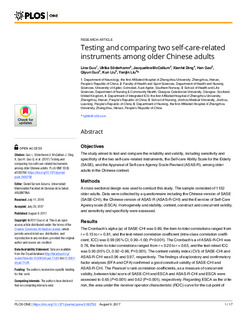| dc.description.abstract | Objectives The study aimed to test and compare the reliability and validity, including sensitivity and specificity of the two self-care-related instruments, the Self-care Ability Scale for the Elderly (SASE), and the Appraisal of Self-care Agency Scale-Revised (ASAS-R), among older adults in the Chinese context. Methods A cross-sectional design was used to conduct this study. The sample consisted of 1152 older adults. Data were collected by a questionnaire including the Chinese version of SASE (SASE-CHI), the Chinese version of ASAS-R (ASAS-R-CHI) and the Exercise of Self-Care Agency scale (ESCA). Homogeneity and stability, content, construct and concurrent validity, and sensitivity and specificity were assessed. Results The Cronbach's alpha (α) of SASE-CHI was 0.89, the item-to-total correlations ranged from r = 0.15 to r = 0.81, and the test-retest correlation coefficient (intra-class correlation coefficient, ICC) was 0.99 (95% CI, 0.99±1.00; P<0.001). The Cronbach's α of ASAS-R-CHI was 0.78, the item-to-total correlations ranged from r = 0.20 to r = 0.65, and the test-retest ICC was 0.95 (95% CI, 0.92±0.96; P<0.001). The content validity index (CVI) of SASE-CHI and ASAS-R-CHI was 0.96 and 0.97, respectively. The findings of exploratory and confirmatory factor analyses (EFA and CFA) confirmed a good construct validity of SASE-CHI and ASAS-R-CHI. The Pearson's rank correlation coefficients, as a measure of concurrent validity, between total score of SASE-CHI and ESCA and ASAS-R-CHI and ESCA were assessed to 0.65 (P<0.001) and 0.62 (P<0.001), respectively. Regarding ESCA as the criterion, the area under the receiver operator characteristic (ROC) curve for the cut-point of SASE-CHI and ASAS-R-CHI were 0.93 (95% CI, 0.91±0.94) and 0.83 (95% CI, 0.80±0.86), respectively. Conclusion There is no significant difference between the two instruments. Each has its own characteristics, but SASE-CHI is more suitable for older adults. The key point is that the users can choose the most appropriate scale according to the specific situation. | |

